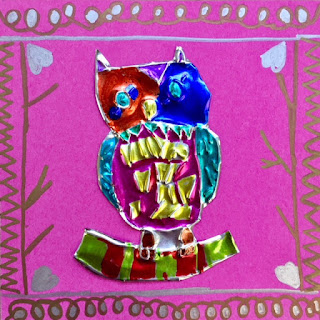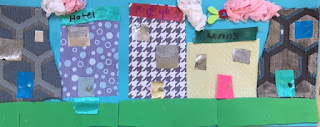The first country on our Arts Around the World journey this year is Mexico. Our first project focused on Día de Muertos or Day of the Dead, a holiday celebrated in Mexico. For our second project, we focused on the folk art of Mexico, specifically from the Oaxaca region. Folk art is popular art forms that have been passed down through the generations. We looked at one particular form of folk art called hojalata ("oh-ha-la-ta") art, or tin art.
Folk artists use tin to create these artworks, cutting and shaping the tin and using different techniques, like embossing, to create patterns and designs on the metal. Artists then add lacquer or enamel on the tin in bright colors. After looking at examples of hojalata art, students created sketches of different animals from Mexico.
Using reference images, students brainstormed a few different ideas before choosing one for their final artwork. The following class, students learned about embossing, which is a technique where you carve, mold or stamp a design on a surface, like paper or metal, so that it stands out in relief. The two materials typically used for embossing are paper and metal. Metal embossing is used to put a design on metal sheets.
The metal is pushed with an embossing tool or stylus to create a raised effect on the opposite side. Students taped their design on top of an aluminum sheet, so it would not move around. Then they placed this on top of a piece of felt, which provided a softer surface to work on. Using a wooden stylus, students pressed down on all their drawn lines.
Students were amazed to see their lines coming through, creating a bumpy raised design on the opposite side of the metal sheet! After they went over all their lines once, they removed the paper on top and went over all their lines again with a blunt pencil. This creates a bumpy texture that you can see on both sides of the metal, but we used the side where the lines were raised.
After students were done embossing, they used colored Sharpie markers to color in the areas in between the raised lines of their design. The lines created borders for their shapes, and we discussed color choice and how to use complementary colors to help their designs and patterns stand out. The final step involved getting the metal hot glued to a background color, creating a frame for their work.
To share our finished work with each other, we did a turn and talk using our fortune tellers. Students picked partners and used their fortune tellers to ask each other questions about their work. We also did a gallery walk, where we walked around the room to see everyone's work. Below are some examples of our finished embossed hojalata artworks:
 |
| Alex, 2nd Grade (Hinds) |
 |
| Andy, 2nd Grade (Pearse) |
 |
| Ava, 2nd Grade (Hinds) |
 |
| Kaiwan, 2nd Grade (Hinds) |
 |
| Lucas, 2nd Grade (Pearse) |
 |
| Manha, 2nd Grade (O'Connor) |
 |
| Mariana, 2nd Grade (Stone) |
 |
| Ruken, 2nd Grade (O'Connor) |
 |
| Sarah, 2nd Grade (Stone) |
 |
| Shane, 2nd Grade (Pearse) |
 |
| Stephanie, 2nd Grade (Pearse) |



















































